Global Active Electronic Components Market Forecast
- The US$300.2 Bn market for active electronic components to rise high up to US$478.9 Bn by 2030
- Market size likely to exhibit a CAGR of 6.9% between 2023 and 2030
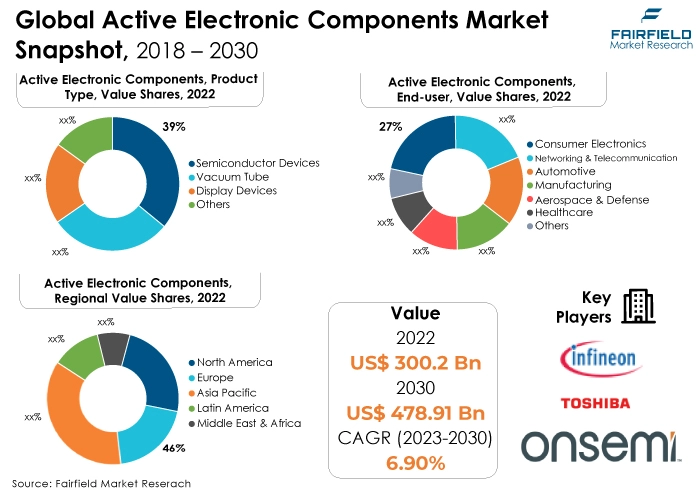
Quick Report Digest
- The market for active electronic components is expanding as a result of the rising demand for electric and hybrid vehicles, which has increased the use of power electronics in automotive applications.
- The market for active electronic components is expanding as a result of the development of novel materials like graphene and carbon nanotubes, which offer high conductivity and distinctive electronic properties.
- The market is expanding as a result of the growing use of active electronic components in medical equipment like implanted devices, surgical instruments, and diagnostic tools.
- Active electronic component deliveries may be delayed as a result of supply chain disruptions, which may impede market expansion. Moreover, as people become more apprehensive of connected gadgets, the presence of cyberthreats and attacks could restrict industry expansion.
- Due to the growing adoption of semiconductor devices in applications including home appliances, personal computers, phones, networking equipment, and others, the semiconductor segment have the greatest revenue share in the target market.
- The consumer electronics end-use sector represented the greatest market share in 2022. Segment growth is mostly being driven by the increase in demand for semiconductor devices, such as smartphones, wearable technology, digital cameras, and gaming consoles.
- The Asia-Pacific region is anticipated to account for the highest share of the global active electronic components market with the biggest markets in the region being in nations like China, South Korea, Japan, and Taiwan. The increased demand for electronic gadgets like smartphones, tablets, and laptops is the main driver of growth in this region.
- North America will have a significant rate of growth in the active electronic components market during the forecast period. The increased adoption of cutting-edge technology like the IoT, smart homes and buildings, and autonomous cars is the main driver of growth in this sector.
A Look Back and a Look Forward - Comparative Analysis
During the anticipated period, the demand for consumer active electronic devices like smartphones and laptops is expected to propel the market toward growth. The use and installation of active electronic components will expand as the number of devices rises, which is a key element driving this market. Additionally, the demand for various electronic devices has grown as a result of expanding automation in the automobile industry, which will support this segment's market expansion throughout the forecasted period.
Between 2018 and 2022, the market for active electronic components grew significantly. Rising demand for electronic components in a variety of sectors, including consumer electronics, automotive, industrial automation, and telecommunications, defined the market. Furthermore, the market kept growing as a result of developments in the fields of AI, electric and autonomous vehicles, and ongoing industry-wide digital transformation. These elements increased demand for sophisticated active electronic devices, which drive cutting-edge technology.
In the upcoming years, the growing use of connected devices in industrial facilities is expected to propel the market. The markets for active and passive electronic components are expanding due to the growing interest in renewable energy sources such as wind and solar power. Moreover, the introduction of 5G networks and the need for high-speed communication also present prospects for active and passive electrical components.
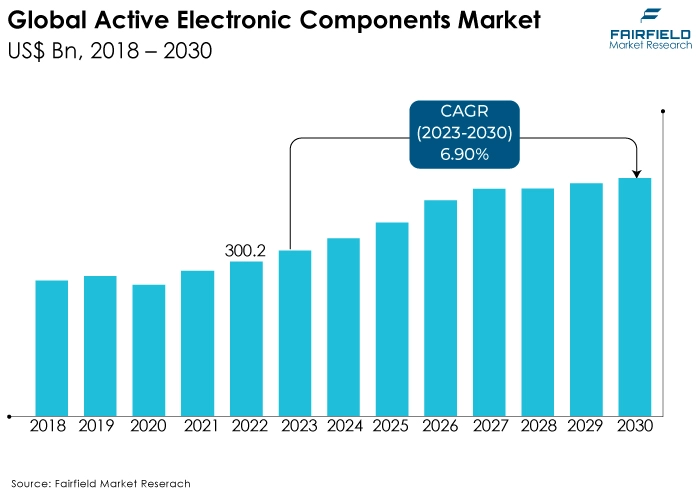
Key Growth Determinants
- Swelling Consumer Electronics Industry
The need for active electronic components has increased as a result of smartphones, other wearable technology, industrial automation, and other factors. Growing demand for active electronic components from the automotive and healthcare sectors, as well as increased technology usage, are driving the market for active electronic components.
As vehicles have become more complex and there is a greater demand for high-tech cars, the use of active electronic components has expanded. Furthermore, the industry is expanding as a result of both the rising use of renewable energy sources and active electronic components in consumer goods and wearables. The global use of active electronic components is being fueled by their increasing application in connected devices.
- Unprecedented IoT Penetration
The need for active electronic components is mainly being driven by the rising demand for IoT. An interconnected system of objects or things with electronics, software, sensors, and network connectivity is known as the Internet of Things (IoT). These sensors and actuators can be used by an Internet-connected device to collect data, record it, and send it instantly to other computer devices due to IoT technology.
Furthermore, semiconductor integrated circuits (ICs) with memory, a microcontroller, wireless connectivity, sensors, and a range of analog and digital components are a common feature of IoT devices. Moreover, the demand for IoT chipsets that are built into IoT devices will rise as there are more and more IoT applications. IoT-based products have been introduced by many big firms.
- Increasing Investments in Smart City Projects
The market for active electronic components has recently seen an increase in investments in smart city projects. The infrastructure of a city is equipped with various information and communication technologies as part of a smart city development project. Building smart cities is a major focus for nations around the world in an effort to better manage their resources and assets.
Furthermore, smart city solutions, including intelligent lighting, intelligent traffic management, intelligent utilities, and intelligent water and waste management, rely heavily on the participation of the many market stakeholders, including the information and communications technology (ICT) service providers, relevant local and regional governments, and smart device manufacturers.
Moreover, investments in smart cities will speed the construction of the network infrastructure required to allow machine-to-machine (M2M) communication. The need for active electronic components is further fueled by significant investments made by developing nations in smart city initiatives.
Major Growth Barriers
- Complicated Regulatory Landscape
The market has faced difficulties as a result of a complicated regulatory landscape. For market participants, observing strict standards for product safety, environmental sustainability, and intellectual property rights presented challenges. Resources and knowledge were needed in order to adjust to changing rules and ensure compliance throughout the supply chain.
- Supply Chain Disruptions
Due to supply chain interruptions, the market for active electronic components faced difficulties in 2022. Raw material shortages, geopolitical unrest, trade disputes, and natural calamities all have an impact on the availability and price of components.
For instance, delays in production and higher costs for electronic equipment and devices were caused by interruptions in semiconductor supply chains, which had an impact on many industries
Key Trends and Opportunities to Look at
- Growing Inclination Toward Energy Efficiency
The market for active electronic components has seen a major trend toward energy efficiency. Manufacturers concentrated on creating energy-efficient components to lower power usage and carbon footprint in response to growing environmental concerns. For instance, important trends were developments in power management ICs and energy-efficient display technology.
- Rising Miniaturisation Trend, and Integration of Active Components
A significant development was the ongoing miniaturisation and integration of active components. Compact and integrated components were created as a result of consumer desire for increasingly compact, powerful electronic products.
For instance, advances in semiconductor technology made it possible to combine several functions onto a single chip, making ICs smaller and more effective.
- Advancements in Technology
The market for active electronic components was significantly impacted by the quick development of technology, particularly in the areas of AI, ML, IoT, and 5G connection.
To be implemented and work properly, these technologies need cutting-edge components. Taking the implementation of 5G networks as an example, the demand for active components such transceivers and amplifiers to provide faster data speeds and connection increased in 2022.
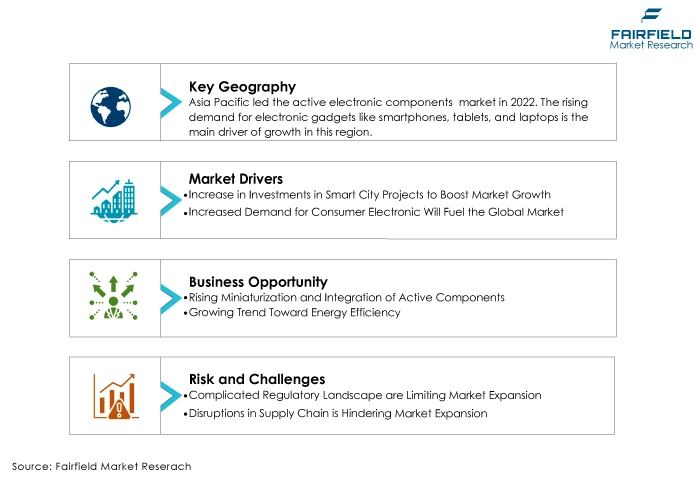
How Does the Regulatory Scenario Shape this Industry?
Safety and quality requirements for electronic components are frequently set by regulations. To guarantee their products are safe for consumers and meet specific performance requirements, manufacturers must abide by these standards.
Regulation compliance may have an impact on the design, production methods, and materials used in active electronic components. In addition, environmental rules like the WEEE (Waste Electrical and Electronic Equipment) and RoHS (Restriction of Hazardous compounds) directives regulate the proper disposal of electronic waste as well as the usage of specific hazardous compounds in electronic components. These rules can affect component design and material selection to lessen their negative effects on the environment.
Fairfield’s Ranking Board
Top Segments
- Semiconductor Devices Category Dominant over Vacuum Tubes Segment
The semiconductor devices segment dominated the market in 2022. The market's increasing demand for energy-efficient products and ongoing product innovation are the key drivers of the segment's growth. Transistors, diodes, optoelectronic components, and integrated circuits are further divided under the semiconductor devices category.
The segment's growth is also attributable to the widespread use of semiconductor devices in a range of products, including home appliances, personal computers, mobile phones, and network equipment.
The vacuum tubes category is expected to grow significantly over the forecast period. Active electronic components use vacuum tubes, which are electronic devices that control the flow of electrons through an evacuated glass or metal envelope.
The original vacuum tubes were employed in radio transmitters and receivers, but they also had many other uses, such as in radar, electronic computers, oscillators, and amplifiers. Contrary to semiconductor devices, vacuum tubes are used in active electronic components.
- Adoption Maximum Across Consumer Electronics Category
In 2022, the consumer electronics category dominated the market, and it is predicted to grow significantly over the course of the forecast period. The main driver of the expansion is anticipated demand for microelectronic appliances used in various consumer goods, gaming consoles, and various devices.
Additionally, there is a growing demand for networking hardware, including modems, repeaters, routers, and gateways, notably in the fields of home automation and business automation.
Furthermore, the automotive category is expected to expand significantly. For the purpose of attracting customers, automotive manufacturers worldwide concentrate on integrating diverse technologies and technology.
The market for automotive active electronic components has been heavily impacted by the rising popularity of premium and ultra-luxury vehicles. The use of electronic components in vehicles has expanded as a result of the greater reliance that vehicles have on electronic parts and safety systems in recent years.
Regional Frontrunners
Asia Pacific at the Forefront
The region with the biggest market share for active electronic components is expected to be Asia Pacific during that forecast period. The number of people using the internet and using it on smartphones and other portable devices is rising, which is causing the digital map to grow quickly. Digital maps' growing use opens up new opportunities for the Asia Pacific region.
Autonomous vehicles use digital map systems for route planning and navigation. The advent of 3D maps and other recent advancements in digital mapping, along with the ease with which a location can be identified and understood, have been the primary factors driving the expansion of the Asian industry.
China is also the world's leading producer and exporter of consumer electronics products. The consumer electronics industry has changed as a result of lucrative features and innovative technology, which has boosted demand for active electronic components in the area.
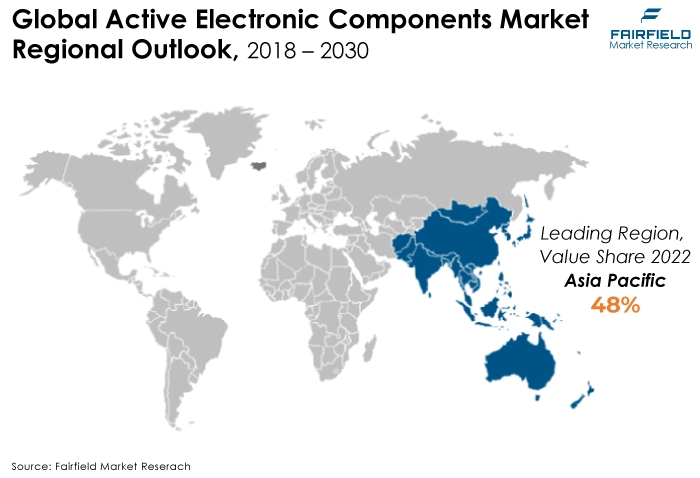
North America Anticipates Gains from 5G Expansion, and Smart City Initiatives
The market for active electronic components is expanding at the fastest rate in North America, which presents a significant opportunity for the industry. The US federal government is making significant investments nationwide in the development of smart cities. Micro-electromechanical systems (MEMS), and renewable energy sources are primarily responsible for the rise in these sectors.
Additionally, the growing market for active electronic components is primarily driven by the region's rising demand for portable electronic gadgets. In addition, the US's growing trend toward smart homes and connected autos has given telecom operators in the area fresh incentives to make significant investments in the construction of 5G network infrastructure.
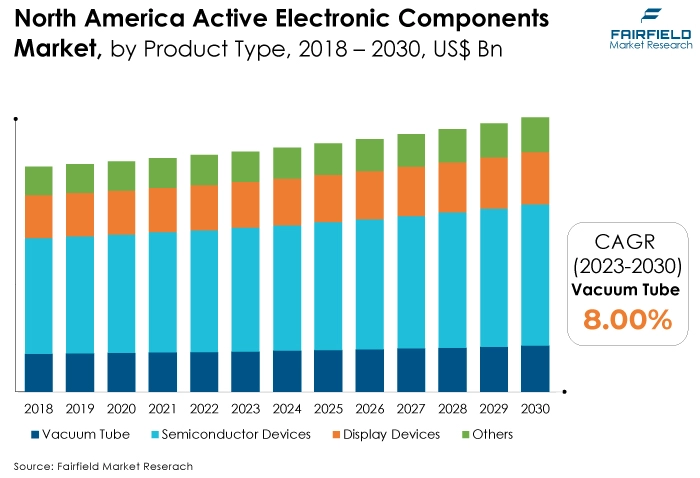
Fairfield’s Competitive Landscape Analysis
Because there are numerous companies in the industry, it is expected that there would be more competition. The integration of cutting-edge technology with active electronic components used in consumer electronics is a major focus for major players in research and development.
In addition, the major players are pursuing a number of strategic measures, such as mergers and acquisitions and the introduction of new products, to enhance their position in the market, seize a substantial market share, and boost overall profitability.
Who are the Leaders in Global Active Electronic Components Space?
- Infineon Technologies AG
- NXP Semiconductors NV
- Texas Instruments, Inc.
- Toshiba Corp.
- Intel Corp.
- Maxim Integrated
- Broadcom, Inc.
- Qualcomm, Inc.
- Analog Devices, Inc.
- Advanced Micro Devices
- Microchip Technology, Inc.
- Monolithic Power Systems, Inc.
- Renesas Electronics Corporation
- STMicroelectronics N.V.
- ON Semiconductor
Key Company Developments
New Product Launch
- June 2023: With their novel top-side cooling packaging, NXP has made a significant advancement in 5G radio technology. By enabling smaller, lighter radio equipment, this ground-breaking technology facilitates a quicker and easier deployment of 5G base stations. Smaller and thinner radios are made possible by the new top-side cooling for RF power, which simplifies the deployment of 5G infrastructure.
- June 2023: A line of octal high-side switches from STMicroelectronics have incorporated galvanic isolation to increase longevity. The low RDS (on) of these switches, which is under 260 m, leads to increased energy efficiency. They also provide protection diagnostics, which improve dependability and make troubleshooting easier.
- February 2023: The expansion of Infineon Technologies' power semiconductor production facility in Dresden, Germany, was announced. This is consistent with the industrial and automotive sectors' rising demand for power semiconductors.
- January 2023: In order to fulfill the demands of the upcoming E/E (electrical/electronic) architectures, Renesas has unveiled a new automotive intelligent power device (IPD) that safely and adaptably manages power distribution in automobiles.
Collaboration
- May 2023: On the implementation of 4D imaging radar, NIO and NXP worked together. NIO is able to considerably enhance sensor resolution, increase detection range, and enable the greatest levels of autonomous driving thanks to NXP's imaging radar technology.
An Expert’s Eye
Demand and Future Growth
Due to increased demand from a variety of industries and the growing use of linked devices, the market for active electronic components is expanding significantly. These elements help the market for active electronic components grow in importance and size.
Additionally, the potential use of these components in the creation of network and communication equipment for the 5G infrastructure is projected to boost the market's growth. The market for active electronics components is anticipated to grow as a result of the rising demand for such systems.
Supply Side of the Market
According to our analysis, active electronic components are primarily imported from China, and Taiwan. China has a thriving electronics manufacturing sector, with various businesses creating parts including integrated circuits, microcontrollers, and semiconductors.
Taiwan is also the location of important semiconductor foundries like Taiwan Semiconductor Manufacturing Company (TSMC), which are essential to the global supply of active electronic components.
The worldwide supply chain for electronics may be significantly impacted by changes and events in China, and Taiwan. For instance, disruptions in the production of semiconductors caused by geopolitical unrest or natural disasters in these areas may result in shortages and pricing changes in the global electronics industry.
Global Active Electronic Components Market is Segmented as Below:
By Product Type
- Semiconductor Devices
- Diode
- Transistors
- Integrated Circuits (ICs)
- Optoelectronics
- Vacuum Tube
- Display Devices
- Others
By End User
- Consumer Electronics
- Networking & Telecommunication
- Automotive
- Manufacturing
- Aerospace & Defense
- Healthcare
- Others
By Geographic Coverage:
- North America
- U.S.
- Canada
- Europe
- Germany
- U.K.
- France
- Italy
- Turkey
- Russia
- Rest of Europe
- Asia Pacific
- China
- Japan
- South Korea
- India
- Southeast Asia
- Rest of Asia Pacific
- Latin America
- Brazil
- Mexico
- Argentina
- Rest of Latin America
- Middle East & Africa
- GCC
- South Africa
- Egypt
- Nigeria
- Rest of Middle East & Africa
1. Executive Summary
1.1. Global Active Electronic Components Market Snapshot
1.2. Future Projections
1.3. Key Market Trends
1.4. Regional Snapshot, by Value, 2022
1.5. Analyst Recommendations
2. Market Overview
2.1. Market Definitions and Segmentations
2.2. Market Dynamics
2.2.1. Drivers
2.2.2. Restraints
2.2.3. Market Opportunities
2.3. Value Chain Analysis
2.4. Porter’s Five Forces Analysis
2.5. COVID-19 Impact Analysis
2.5.1. Supply
2.5.2. Demand
2.6. Impact of Ukraine-Russia Conflict
2.7. Economic Overview
2.7.1. World Economic Projections
2.8. PESTLE Analysis
3. Global Active Electronic Components Market Outlook, 2018 - 2030
3.1. Global Active Electronic Components Market Outlook, by Product Type, Value (US$ Bn), 2018 - 2030
3.1.1. Key Highlights
3.1.1.1. Semiconductor Devices
3.1.1.1.1. Diode
3.1.1.1.2. Transistors
3.1.1.1.3. Integrated Circuits (ICs)
3.1.1.1.4. Optoelectronics
3.1.1.2. Vacuum Tube
3.1.1.3. Display Devices
3.1.1.4. Others
3.2. Global Active Electronic Components Market Outlook, by End User, Value (US$ Bn), 2018 - 2030
3.2.1. Key Highlights
3.2.1.1. Consumer Electronics
3.2.1.2. Networking & Telecommunication
3.2.1.3. Automotive
3.2.1.4. Manufacturing
3.2.1.5. Aerospace & Defense
3.2.1.6. Healthcare
3.2.1.7. Others
3.3. Global Active Electronic Components Market Outlook, by Region, Value (US$ Bn), 2018 - 2030
3.3.1. Key Highlights
3.3.1.1. North America
3.3.1.2. Europe
3.3.1.3. Asia Pacific
3.3.1.4. Latin America
3.3.1.5. Middle East & Africa
4. North America Active Electronic Components Market Outlook, 2018 - 2030
4.1. North America Active Electronic Components Market Outlook, by Product Type, Value (US$ Bn), 2018 - 2030
4.1.1. Key Highlights
4.1.1.1. Semiconductor Devices
4.1.1.1.1. Diode
4.1.1.1.2. Transistors
4.1.1.1.3. Integrated Circuits (ICs)
4.1.1.1.4. Optoelectronics
4.1.1.2. Vacuum Tube
4.1.1.3. Display Devices
4.1.1.4. Others
4.2. North America Active Electronic Components Market Outlook, by End User, Value (US$ Bn), 2018 - 2030
4.2.1. Key Highlights
4.2.1.1. Consumer Electronics
4.2.1.2. Networking & Telecommunication
4.2.1.3. Automotive
4.2.1.4. Manufacturing
4.2.1.5. Aerospace & Defense
4.2.1.6. Healthcare
4.2.1.7. Others
4.2.2. Market Attractiveness Analysis
4.3. North America Active Electronic Components Market Outlook, by Country, Value (US$ Bn), 2018 - 2030
4.3.1. Key Highlights
4.3.1.1. U.S. Active Electronic Components Market by Product Type, Value (US$ Bn), 2018 - 2030
4.3.1.2. U.S. Active Electronic Components Market, by End User, Value (US$ Bn), 2018 - 2030
4.3.1.3. Canada Active Electronic Components Market by Product Type, Value (US$ Bn), 2018 - 2030
4.3.1.4. Canada Active Electronic Components Market, by End User, Value (US$ Bn), 2018 - 2030
4.3.2. BPS Analysis/Market Attractiveness Analysis
5. Europe Active Electronic Components Market Outlook, 2018 - 2030
5.1. Europe Active Electronic Components Market Outlook, by Product Type, Value (US$ Bn), 2018 - 2030
5.1.1. Key Highlights
5.1.1.1. Semiconductor Devices
5.1.1.1.1. Diode
5.1.1.1.2. Transistors
5.1.1.1.3. Integrated Circuits (ICs)
5.1.1.1.4. Optoelectronics
5.1.1.2. Vacuum Tube
5.1.1.3. Display Devices
5.1.1.4. Others
5.2. Europe Active Electronic Components Market Outlook, by End User, Value (US$ Bn), 2018 - 2030
5.2.1. Key Highlights
5.2.1.1. Consumer Electronics
5.2.1.2. Networking & Telecommunication
5.2.1.3. Automotive
5.2.1.4. Manufacturing
5.2.1.5. Aerospace & Defense
5.2.1.6. Healthcare
5.2.1.7. Others
5.2.2. BPS Analysis/Market Attractiveness Analysis
5.3. Europe Active Electronic Components Market Outlook, by Country, Value (US$ Bn), 2018 - 2030
5.3.1. Key Highlights
5.3.1.1. Germany Active Electronic Components Market by Product Type, Value (US$ Bn), 2018 - 2030
5.3.1.2. Germany Active Electronic Components Market, by End User, Value (US$ Bn), 2018 - 2030
5.3.1.3. U.K. Active Electronic Components Market by Product Type, Value (US$ Bn), 2018 - 2030
5.3.1.4. U.K. Active Electronic Components Market, by End User, Value (US$ Bn), 2018 - 2030
5.3.1.5. France Active Electronic Components Market by Product Type, Value (US$ Bn), 2018 - 2030
5.3.1.6. France Active Electronic Components Market, by End User, Value (US$ Bn), 2018 - 2030
5.3.1.7. Italy Active Electronic Components Market by Product Type, Value (US$ Bn), 2018 - 2030
5.3.1.8. Italy Active Electronic Components Market, by End User, Value (US$ Bn), 2018 - 2030
5.3.1.9. Turkey Active Electronic Components Market by Product Type, Value (US$ Bn), 2018 - 2030
5.3.1.10. Turkey Active Electronic Components Market, by End User, Value (US$ Bn), 2018 - 2030
5.3.1.11. Russia Active Electronic Components Market by Product Type, Value (US$ Bn), 2018 - 2030
5.3.1.12. Russia Active Electronic Components Market, by End User, Value (US$ Bn), 2018 - 2030
5.3.1.13. Rest of Europe Active Electronic Components Market by Product Type, Value (US$ Bn), 2018 - 2030
5.3.1.14. Rest of Europe Active Electronic Components Market, by End User, Value (US$ Bn), 2018 - 2030
5.3.2. BPS Analysis/Market Attractiveness Analysis
6. Asia Pacific Active Electronic Components Market Outlook, 2018 - 2030
6.1. Asia Pacific Active Electronic Components Market Outlook, by Product Type, Value (US$ Bn), 2018 - 2030
6.1.1. Key Highlights
6.1.1.1. Semiconductor Devices
6.1.1.1.1. Diode
6.1.1.1.2. Transistors
6.1.1.1.3. Integrated Circuits (ICs)
6.1.1.1.4. Optoelectronics
6.1.1.2. Vacuum Tube
6.1.1.3. Display Devices
6.1.1.4. Others
6.2. Asia Pacific Active Electronic Components Market Outlook, by End User, Value (US$ Bn), 2018 - 2030
6.2.1. Key Highlights
6.2.1.1. Consumer Electronics
6.2.1.2. Networking & Telecommunication
6.2.1.3. Automotive
6.2.1.4. Manufacturing
6.2.1.5. Aerospace & Defense
6.2.1.6. Healthcare
6.2.1.7. Others
6.2.2. BPS Analysis/Market Attractiveness Analysis
6.3. Asia Pacific Active Electronic Components Market Outlook, by Country, Value (US$ Bn), 2018 - 2030
6.3.1. Key Highlights
6.3.1.1. China Active Electronic Components Market by Product Type, Value (US$ Bn), 2018 - 2030
6.3.1.2. China Active Electronic Components Market, by End User, Value (US$ Bn), 2018 - 2030
6.3.1.3. Japan Active Electronic Components Market by Product Type, Value (US$ Bn), 2018 - 2030
6.3.1.4. Japan Active Electronic Components Market, by End User, Value (US$ Bn), 2018 - 2030
6.3.1.5. South Korea Active Electronic Components Market by Product Type, Value (US$ Bn), 2018 - 2030
6.3.1.6. South Korea Active Electronic Components Market, by End User, Value (US$ Bn), 2018 - 2030
6.3.1.7. India Active Electronic Components Market by Product Type, Value (US$ Bn), 2018 - 2030
6.3.1.8. India Active Electronic Components Market, by End User, Value (US$ Bn), 2018 - 2030
6.3.1.9. Southeast Asia Active Electronic Components Market by Product Type, Value (US$ Bn), 2018 - 2030
6.3.1.10. Southeast Asia Active Electronic Components Market, by End User, Value (US$ Bn), 2018 - 2030
6.3.1.11. Rest of Asia Pacific Active Electronic Components Market by Product Type, Value (US$ Bn), 2018 - 2030
6.3.1.12. Rest of Asia Pacific Active Electronic Components Market, by End User, Value (US$ Bn), 2018 - 2030
6.3.2. BPS Analysis/Market Attractiveness Analysis
7. Latin America Active Electronic Components Market Outlook, 2018 - 2030
7.1. Latin America Active Electronic Components Market Outlook, by Product Type, Value (US$ Bn), 2018 - 2030
7.1.1. Key Highlights
7.1.1.1. Semiconductor Devices
7.1.1.1.1. Diode
7.1.1.1.2. Transistors
7.1.1.1.3. Integrated Circuits (ICs)
7.1.1.1.4. Optoelectronics
7.1.1.2. Vacuum Tube
7.1.1.3. Display Devices
7.1.1.4. Others
7.2. Latin America Active Electronic Components Market Outlook, by End User, Value (US$ Bn), 2018 - 2030
7.2.1. Key Highlights
7.2.1.1. Consumer Electronics
7.2.1.2. Networking & Telecommunication
7.2.1.3. Automotive
7.2.1.4. Manufacturing
7.2.1.5. Aerospace & Defense
7.2.1.6. Healthcare
7.2.1.7. Others
7.2.2. BPS Analysis/Market Attractiveness Analysis
7.3. Latin America Active Electronic Components Market Outlook, by Country, Value (US$ Bn), 2018 - 2030
7.3.1. Key Highlights
7.3.1.1. Brazil Active Electronic Components Market by Product Type, Value (US$ Bn), 2018 - 2030
7.3.1.2. Brazil Active Electronic Components Market, by End User, Value (US$ Bn), 2018 - 2030
7.3.1.3. Mexico Active Electronic Components Market by Product Type, Value (US$ Bn), 2018 - 2030
7.3.1.4. Mexico Active Electronic Components Market, by End User, Value (US$ Bn), 2018 - 2030
7.3.1.5. Argentina Active Electronic Components Market by Product Type, Value (US$ Bn), 2018 - 2030
7.3.1.6. Argentina Active Electronic Components Market, by End User, Value (US$ Bn), 2018 - 2030
7.3.1.7. Rest of Latin America Active Electronic Components Market by Product Type, Value (US$ Bn), 2018 - 2030
7.3.1.8. Rest of Latin America Active Electronic Components Market, by End User, Value (US$ Bn), 2018 - 2030
7.3.2. BPS Analysis/Market Attractiveness Analysis
8. Middle East & Africa Active Electronic Components Market Outlook, 2018 - 2030
8.1. Middle East & Africa Active Electronic Components Market Outlook, by Product Type, Value (US$ Bn), 2018 - 2030
8.1.1. Key Highlights
8.1.1.1. Semiconductor Devices
8.1.1.1.1. Diode
8.1.1.1.2. Transistors
8.1.1.1.3. Integrated Circuits (ICs)
8.1.1.1.4. Optoelectronics
8.1.1.2. Vacuum Tube
8.1.1.3. Display Devices
8.1.1.4. Others
8.2. Middle East & Africa Active Electronic Components Market Outlook, by End User, Value (US$ Bn), 2018 - 2030
8.2.1. Key Highlights
8.2.1.1. Consumer Electronics
8.2.1.2. Networking & Telecommunication
8.2.1.3. Automotive
8.2.1.4. Manufacturing
8.2.1.5. Aerospace & Defense
8.2.1.6. Healthcare
8.2.1.7. Others
8.2.2. BPS Analysis/Market Attractiveness Analysis
8.3. Middle East & Africa Active Electronic Components Market Outlook, by Country, Value (US$ Bn), 2018 - 2030
8.3.1. Key Highlights
8.3.1.1. GCC Active Electronic Components Market by Product Type, Value (US$ Bn), 2018 - 2030
8.3.1.2. GCC Active Electronic Components Market, by End User, Value (US$ Bn), 2018 - 2030
8.3.1.3. South Africa Active Electronic Components Market by Product Type, Value (US$ Bn), 2018 - 2030
8.3.1.4. South Africa Active Electronic Components Market, by End User, Value (US$ Bn), 2018 - 2030
8.3.1.5. Egypt Active Electronic Components Market by Product Type, Value (US$ Bn), 2018 - 2030
8.3.1.6. Egypt Active Electronic Components Market, by End User, Value (US$ Bn), 2018 - 2030
8.3.1.7. Nigeria Active Electronic Components Market by Product Type, Value (US$ Bn), 2018 - 2030
8.3.1.8. Nigeria Active Electronic Components Market, by End User, Value (US$ Bn), 2018 - 2030
8.3.1.9. Rest of Middle East & Africa Active Electronic Components Market by Product Type, Value (US$ Bn), 2018 - 2030
8.3.1.10. Rest of Middle East & Africa Active Electronic Components Market, by End User, Value (US$ Bn), 2018 - 2030
8.3.2. BPS Analysis/Market Attractiveness Analysis
9. Competitive Landscape
9.1. Product vs Application Heatmap
9.2. Manufacturer vs Application Heatmap
9.3. Company Market Share Analysis, 2022
9.4. Competitive Dashboard
9.5. Company Profiles
9.5.1. Infineon Technologies AG
9.5.1.1. Company Overview
9.5.1.2. Product Portfolio
9.5.1.3. Financial Overview
9.5.1.4. Business Strategies and Development
9.5.2. NXP Semiconductors NV
9.5.2.1. Company Overview
9.5.2.2. Product Portfolio
9.5.2.3. Financial Overview
9.5.2.4. Business Strategies and Development
9.5.3. Texas Instruments Inc.
9.5.3.1. Company Overview
9.5.3.2. Product Portfolio
9.5.3.3. Financial Overview
9.5.3.4. Business Strategies and Development
9.5.4. Toshiba Corp.
9.5.4.1. Company Overview
9.5.4.2. Product Portfolio
9.5.4.3. Financial Overview
9.5.4.4. Business Strategies and Development
9.5.5. Intel Corp.
9.5.5.1. Company Overview
9.5.5.2. Product Portfolio
9.5.5.3. Financial Overview
9.5.5.4. Business Strategies and Development
9.5.6. Maxim Integrated
9.5.6.1. Company Overview
9.5.6.2. Product Portfolio
9.5.6.3. Financial Overview
9.5.6.4. Business Strategies and Development
9.5.7. Broadcom, Inc.
9.5.7.1. Company Overview
9.5.7.2. Product Portfolio
9.5.7.3. Financial Overview
9.5.7.4. Business Strategies and Development
9.5.8. Qualcomm, Inc.
9.5.8.1. Company Overview
9.5.8.2. Product Portfolio
9.5.8.3. Financial Overview
9.5.8.4. Business Strategies and Development
9.5.9. Analog Devices, Inc.
9.5.9.1. Company Overview
9.5.9.2. Product Portfolio
9.5.9.3. Financial Overview
9.5.9.4. Business Strategies and Development
9.5.10. Advanced Micro Devices
9.5.10.1. Company Overview
9.5.10.2. Product Portfolio
9.5.10.3. Financial Overview
9.5.10.4. Business Strategies and Development
9.5.11. Microchip Technology, Inc.
9.5.11.1. Company Overview
9.5.11.2. Product Portfolio
9.5.11.3. Financial Overview
9.5.11.4. Business Strategies and Development
9.5.12. Monolithic Power Systems, Inc.
9.5.12.1. Company Overview
9.5.12.2. Product Portfolio
9.5.12.3. Financial Overview
9.5.12.4. Business Strategies and Development
9.5.13. Renesas Electronics Corporation
9.5.13.1. Company Overview
9.5.13.2. Product Portfolio
9.5.13.3. Financial Overview
9.5.13.4. Business Strategies and Development
9.5.14. STMicroelectronics N.V.
9.5.14.1. Company Overview
9.5.14.2. Product Portfolio
9.5.14.3. Financial Overview
9.5.14.4. Business Strategies and Development
9.5.15. ON Semiconductor
9.5.15.1. Company Overview
9.5.15.2. Product Portfolio
9.5.15.3. Financial Overview
9.5.15.4. Business Strategies and Development
10. Appendix
10.1. Research Methodology
10.2. Report Assumptions
10.3. Acronyms and Abbreviations
|
BASE YEAR |
HISTORICAL DATA |
FORECAST PERIOD |
UNITS |
|||
|
2022 |
|
2018 - 2022 |
2023 - 2030 |
Value: US$ Million |
||
|
REPORT FEATURES |
DETAILS |
|
Product Type Coverage |
|
|
End User Coverage |
|
|
Geographical Coverage |
|
|
Leading Companies |
|
|
Report Highlights |
Key Market Indicators, Macro-micro economic impact analysis, Technological Roadmap, Key Trends, Driver, Restraints, and Future Opportunities & Revenue Pockets, Porter’s 5 Forces Analysis, Historical Trend (2019-2021), Market Estimates and Forecast, Market Dynamics, Industry Trends, Competition Landscape, Category, Region, Country-wise Trends & Analysis, COVID-19 Impact Analysis (Demand and Supply Chain) |
